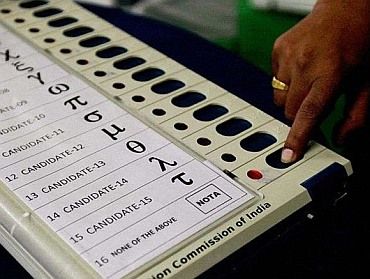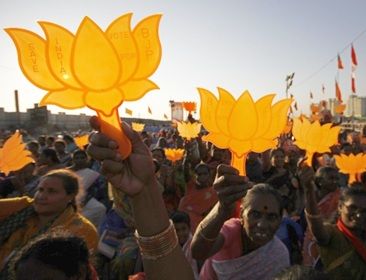When it comes to the winning strike rate, Lalu Prasad Yadav's Rashtriya Janata Dal has emerged victorious on eight of every ten seats it contested while only one of the every three Bharatiya Janata Party candidates managed to win.

Among four major parties, the RJD and the Congress have improved their respective strike rates, while the BJP's has fallen sharply from nearly 90 per cent to just 33 per cent.
The JD-U has also seen its strike rate slip from 81 per cent to 70 per cent.
An analysis of Bihar poll results shows that BJP's allies, the Lok Jan Shakti Party and the Hindustani Awam Morcha (Secular), were among the biggest losers in terms of their strike rates as they managed to win just about 7 per cent and 4 per cent of the seats they contested during the five-phase elections.
The RJD was on top with over 80 per cent strike rate, followed by about 70 per cent of the JD-U and the Congress' 65 per cent.
BJP's winning percentage was about 33 per cent although it had contested on as many as 157 seats -- maximum for any single party. The RJD and the JD-U had contested from 101 seats each while Congress candidates were in the fray across 41 Assembly constituencies.
The BJP had given 42 seats to Ram Vilas Paswan's LJP and 21 seats to the HAM(S).
In the last assembly polls in 2010, the BJP had won 91 out of 102 seats it contested with a strike rate of nearly 90 per cent. The JD-U, on the other hand, had a lower strike rate at that time of 81 per cent (by winning 115 out of 141 seats), when it was in alliance with the BJP.
The RJD had at that point won 22 out of 168 seats (13 per cent) while Congress' performance was the worst with victory from only four out of 243 seats (1.6 per cent).
Photograph: PTI Photo
2.5 pc of electorate opts for 'NOTA' option in Bihar
 There were few takers in the Bihar assembly polls for the 'none of the above' option which was introduced by the Election Commission in 2013 following a Supreme Court judgement.
There were few takers in the Bihar assembly polls for the 'none of the above' option which was introduced by the Election Commission in 2013 following a Supreme Court judgement.
According to figures made available by the poll body, 9,13,561 voters opted for the NOTA option in the state which has 243 assembly seats.
Percentage-wise, around 2.5 per cent voters hit the NOTA button which is placed as the last option on the electronic voting machine. The figures and percentage may change till final results are out.
Out of a total of over 6.68 crore voters, 56.80 per cent had exercised their franchise, the highest ever in Bihar's history, be it Assembly or Lok Sabha polls.
The 'NOTA' option on electronic voting machines this time had its own symbol - a ballot paper with a black cross across it.
The Bihar assembly polls were the first where the symbol appeared next to the 'none of the above' option on the last panel of EVMs and ballot papers. After the Supreme Court order in September, 2013, EC added the NOTA button on the EVMs as the last option on the voting panel.
NOTA was exercised by nearly 60 lakh people in the 2014 Lok Sabha polls.
Prior to the apex court order, those not inclined to vote for any candidate had the option of filling what is popularly called 'form 49-O'. But filling the form at the polling station under Rule 49-O of the Conduct of Elections Rules, 1961, compromised the secrecy of the voter.
The Supreme Court had, however, refused to direct the Election Commission to hold fresh polls if the majority of the electorate exercises the NOTA option while voting.
Something to smile for the Congress
 Alliance route has struck gold for a beleaguered Congress in Bihar polls.
Alliance route has struck gold for a beleaguered Congress in Bihar polls.
Results and trends show that the party led by Sonia Gandhi and Rahul Gandhi is set to bag 26 out of the 41 seats it contested by piggy riding Nitish Kumar and Lalu Prasad. This is against just four seats it secured in the 2010 polls in which it had contested all the 243 seats.
With the Congress contesting limited number of seats, its percentage has come down to 6.7 per cent as against 8.37 per cent in 2010. In the last polls, 216 party candidates had forfeited their deposits.
Partywise, Congress continued to be at the fourth place in the vote percentage in this election too in which BJP has got 24.8 per cent, followed by RJD 18.5 and JD-U 16.7.
Interestingly, independents who constituted a substantial number, have secured 9.7 per cent votes.
In fact, Bihar is a first major victory for the party after the Lok Sabha polls in May last year that had plummeted its stock to the lowest ever -- a mere 44 in the 543-member Lower House.
The party had not done well in the assembly polls of Maharashtra, Haryana, Jharkhand, Delhi and Jammu and Kashmir. In Delhi, it had the ignominy of scoring a duck.
Congress was a dominant force in Bihar till 1989 ruling it for most of the time since independence barring a few years including those after the Emergency which had brought the undivided Janata Party to power on the call of "Total Revolution" by Jaya Prakash Narayan.
For over a quarter of a century, Congress has become a marginalised force in the Hindi heartland of Bihar and Uttar Pradesh in the wake of the Mandal and Mandir surge which saw emergence of the social justice forces and gave strength to the BJP.
BJP tops single-party vote share

As verdict of people in Bihar gave it a thumping victory, the Nitish Kumar-led Grand Alliance also emerged on the top, with the largest vote share of nearly 46 per cent as against NDA's nearly 34 per cent.
On single-party basis, however, the BJP managed a face-saver with a vote share of nearly 24.8 per cent – higher than individual shares of 18.5 per cent for the RJD and 16.7 per cent of the JD-U. The number of seats fought was also highest in case of the BJP.
BJP's NDA allies -- the LJP and the HAM -- could manage only meagre vote shares of 4.8 per cent and 2.2 per cent, respectively.
The Congress, which fought elections as part of the Grand Alliance, also could manage a vote share of only about 6.7 per cent.
As many as 6.68 crore voters exercised their rights during the five-phase elections in the state with 243 Assembly constituencies. Out of these, 38 were reserved for SC and two for ST.
The number of voters in the last Assembly elections in 2010 stood at 5.51 crore, when the BJP and the JD-U had fought together and won 91 and 115 seats, respectively.
This time, JD-U forged the Grand Alliance with the RJD and the Congress, both of which have made remarkable turnarounds. While the Congress had won just four seats last time, its tally was 27 after taking into account winning and leading seats.
The RJD had won 22 seats last time and it has emerged as the single-largest party this time with an estimated 80 seats after taking into account the seats where it was leading.
Its ally JD-U looked set to win 71 seats, as against BJP's 53, as per the latest available data from the Election Commission.
The data showed that the BJP having got over 91.5 lakh votes on a consolidated basis, followed by RJD's 67.9 lakh and about 62 lakh for the JD-U.
Independents also got nearly 35 lakh votes (9.4 per cent) while the Congress polled over 25 lakh votes. Asaduddin Owaisi's AIMIM failed to make any impact in its maiden Bihar elections, with just 0.2 per cent, or about 80,000 votes. This was much lower than even NOTA options chosen by the voters at 2.5 per cent (over 92 lakh votes).
Mulayam Singh Yadav's Samajwadi Party, which had refused to join the Grand Alliance, got about 1 per cent votes (over 37 lakh) while Mayawati-led BSP scored better at 2 per cent (over 74 lakh).











 © 2025
© 2025